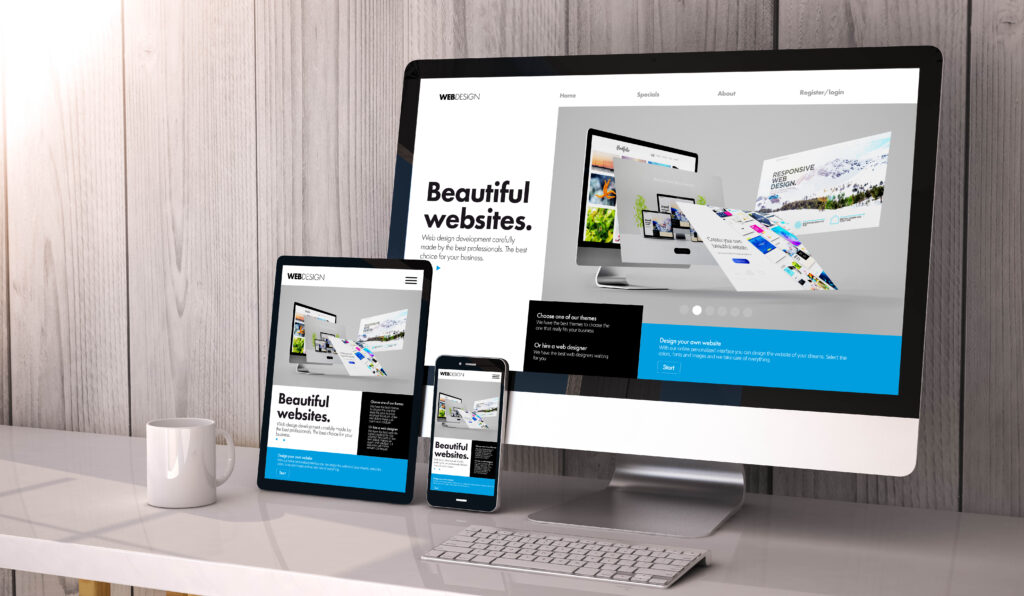Selecting the Ideal Website Builder
Choosing the right website builder can significantly expedite the website creation process. It’s essential to evaluate different builders based on their features, templates, and customisation options. Each builder comes with its own set of strengths, so identifying one that aligns with your specific needs is crucial.
Popular Website Builders like Wix, Squarespace, and WordPress.org each offer unique benefits that cater to different user requirements. For instance, Wix is renowned for its user-friendly interface and extensive range of over 900 templates, which can greatly accelerate the design phase. Squarespace, on the other hand, provides a more streamlined selection of 150 templates, specifically designed for creatives and service-based businesses.
WordPress.org is particularly favoured for its high level of customisation. Its extensive library of over 50,000 plugins provides users with the flexibility to add a multitude of features to their websites, enhancing both functionality and user experience. WordPress.org boasts a library of over 50,000 plugins, providing extensive customisation options for users. This vast selection allows for a more tailored approach, making it a preferred choice for those looking to create a highly customised site.
When selecting a Website Builder, ease of use is a critical factor. A builder with an intuitive interface can save you time and reduce the learning curve, allowing you to focus on content creation and design. Wix excels in this area, offering a drag-and-drop editor that simplifies the building process. Squarespace also provides an easy-to-navigate platform, though it is slightly more complex due to its focus on design and aesthetics.
Another important consideration is the level of support and resources available. Builders like Wix and Squarespace offer robust customer support, including live chat, email support, and comprehensive knowledge bases. WordPress.org, while lacking direct customer service, has a vast community of users and developers who contribute to forums and create tutorials, which can be invaluable resources when troubleshooting issues or seeking advice.
Customisation options are another key aspect to consider. While pre-designed templates can provide a quick start, the ability to customise your site ensures it aligns with your brand and meets your specific needs. WordPress.org is unparalleled in this regard, offering extensive customisation possibilities through its vast library of plugins and themes. WordPress.org boasts a library of over 50,000 plugins, providing extensive customisation options for users.
For those looking for a balance between ease of use and customisation, Wix is a strong contender. Its drag-and-drop interface, combined with a wide range of templates and apps, allows users to create a professional-looking website with minimal effort. Squarespace, with its focus on design, offers a middle ground, providing enough flexibility for customisation while maintaining an emphasis on aesthetically pleasing layouts.
Integration capabilities are also crucial. Builders that offer seamless integration with third-party tools can enhance your website’s functionality and streamline your workflow. Wix, for example, provides over 500 apps that enable users to add various features, from email marketing tools to social media sharing options. This not only simplifies the website management process but also reduces the need for extensive coding knowledge.
Making Use of Pre-designed Templates
Utilising pre-designed templates is a highly efficient way to establish your website’s aesthetic rapidly. Website Builders such as Wix, Squarespace, and WordPress.org offer an extensive range of templates tailored to various industries and styles. This feature allows you to bypass the time-consuming process of designing a website from scratch.
One of the standout features of Wix is its collection of over 900 templates, covering a multitude of categories and themes. This extensive selection makes it simpler for users to find a design that suits their specific needs and preferences, allowing for quicker implementation and less customisation time. Wix, for instance, offers over 900 templates, making it easier for users to quickly find a design that suits their needs.
Squarespace, meanwhile, offers a curated selection of over 150 templates, each designed with a focus on creativity and aesthetics. These templates are particularly beneficial for those in creative fields such as photography, art, or design, as well as service-based businesses that require visually appealing and professional layouts. Squarespace provides over 150 templates, which are particularly useful for creatives and service-based websites.
For users seeking more customisation and flexibility, WordPress.org offers an impressive array of over 10,000 templates. This vast collection caters to content-heavy sites and provides ample opportunities for personalisation to suit unique brand requirements. WordPress.org caters to more content-heavy sites with its extensive collection of over 10,000 templates.
When selecting a template, it’s important to consider how well it aligns with your brand’s identity and goals. Once you’ve chosen a suitable template, customisation is key to ensuring it reflects your unique style. Most website builders allow you to modify colours, fonts, and other design elements. This level of customisation can help you create a site that is both visually appealing and true to your brand.
Additionally, pre-designed templates often come with built-in features and layout options that can further speed up the website creation process. Many templates include predefined sections for headers, footers, galleries, and contact forms, which can be easily adjusted to fit your content. This means you can spend more time focusing on the content and functionality of your site rather than getting bogged down in design details.
Another benefit of using pre-designed templates is the consistency they provide across your website. Templates ensure that your site maintains a uniform look and feel, which is crucial for creating a professional and cohesive online presence. This consistency helps in building trust with your audience and enhances the overall user experience.
In addition to speeding up the design process, pre-designed templates often come with responsive design features. This means your website will automatically adjust to look great on various devices, including desktops, tablets, and smartphones.
Streamlining the Creation of Content
Once you’ve chosen and customised your template, the focus shifts to streamlining your content creation. Efficient content management can save you considerable time and effort, allowing you to concentrate on delivering quality information to your audience.
Website Builders often come with pre-designed content blocks or sections that enable you to format and organise text swiftly and consistently. These blocks ensure a uniform look throughout your site and can be easily tailored to match your branding. Content blocks often include various layout options for text, images, and multimedia, making it simple to create engaging pages without needing advanced design skills.
Incorporating media elements such as images, videos, and infographics can significantly enhance your website’s content, making it more engaging and visually appealing. Most website builders allow for easy integration of these media types, often through drag-and-drop functionality. This means you can add high-quality visuals to your site without spending time on complex coding or formatting tasks. It’s important to optimise these media files for the web to ensure fast loading times and a smooth user experience.
Many Website Builders offer built-in content management systems (CMS) that facilitate the efficient creation, editing, and organisation of your site’s content. These systems allow you to store your content in a central location, making it easy to update and manage. Features like scheduled publishing can be particularly useful, allowing you to plan your content in advance and ensure a steady flow of new information to your audience.
Another effective way to streamline content creation is by using templates for blog posts, articles, and other recurring content types. Many website builders offer these templates, which come with predefined structures for headings, subheadings, and other essential elements. Using these templates can help you maintain consistency across your site and speed up the writing process.
Automated tools and integrations can also play a crucial role in streamlining your content creation. For example, integrating your website builder with a grammar and spell-check tool can help you produce error-free content more quickly. Similarly, SEO tools can guide you in optimising your text for search engines, ensuring that your content reaches a wider audience without requiring extensive manual effort.
Additionally, collaborative features within Website Builders can enhance your workflow, especially if you’re working as part of a team. These features allow multiple users to contribute to the site simultaneously, streamlining the review and approval process. Real-time collaboration tools enable team members to make edits and suggestions, ensuring that content is polished and ready for publication more quickly.
Content scheduling and editorial calendars can further aid in streamlining your content creation process. By planning your content ahead of time, you can ensure a consistent publishing schedule, which is key to maintaining audience engagement. Many website builders offer built-in calendar features or integrations with third-party calendar tools, making it easy to manage your content pipeline.
Finally, leveraging analytics tools can provide valuable insights into how your content is performing. By understanding which types of content resonate most with your audience, you can focus your efforts on creating similar material, thereby streamlining the content creation process. Website builders often include built-in analytics or integrations with popular analytics platforms, providing you with the data you need to make informed decisions.
By taking advantage of these tools and features, you can simplify and expedite the process of creating high-quality content for your website. This approach not only saves you time but also ensures that your site remains engaging and relevant to your audience.
Enhancing Workflow with Integrations
Integrating third-party tools into your Website Builder can significantly enhance your site’s functionality and improve your workflow. By connecting with apps and plugins, you can automate tasks and reduce manual effort. For instance, Wix provides over 500 apps that allow users to quickly add various functionalities to their websites. These integrations can include tools for email marketing, social media sharing, and analytics, all of which contribute to a more efficient website management process.
Email marketing tools can be incredibly valuable for engaging with your audience and driving traffic to your site. Integrations with platforms like Mailchimp or Constant Contact allow you to create and manage email campaigns directly from your Website Builder. These tools often come with templates, automation features, and analytics, making it easier to monitor the success of your campaigns and adjust your strategies accordingly.
Social media integration is another crucial aspect of enhancing your workflow. By connecting your website to your social media profiles, you can streamline the sharing of content and updates. Many website builders offer plugins that automatically post your new content to social media platforms, saving you the time and effort of doing it manually. Additionally, social media feed integrations can display your latest posts directly on your website, keeping your content fresh and engaging for visitors.
Analytics tools provide essential insights into your website’s performance. Integrating with platforms like Google Analytics allows you to track visitor behaviour, monitor traffic sources, and measure the effectiveness of your marketing efforts. These insights can inform your content strategy and help you make data-driven decisions to improve your site. Most website builders offer seamless integration with Google Analytics, enabling you to access valuable data without extensive setup.
For businesses that rely on e-commerce, integrating payment gateways and shopping cart solutions is vital. Website builders like Wix and Squarespace offer integrations with popular payment processors such as PayPal, Stripe, and Square. These integrations ensure secure transactions and provide a smooth checkout experience for your customers. Additionally, e-commerce plugins can offer inventory management, order tracking, and customer relationship management (CRM) features, further streamlining your business operations.
Automation tools like Zapier can also play a significant role in enhancing your workflow. Zapier connects your website builder with over 2,000 apps, enabling you to automate repetitive tasks and create customised workflows. For example, you can set up automations to add new form submissions to a Google Sheet, send a notification to your team via Slack, or trigger an email response. These automations can save you time and reduce the risk of human error.
Customer support integrations can improve the user experience on your website by providing real-time assistance to visitors. Live chat tools like Intercom or Zendesk Chat can be integrated into your Website Builder, allowing you to respond to customer inquiries promptly. This not only enhances customer satisfaction but also increases the likelihood of converting visitors into customers. Additionally, support ticketing systems can help you manage and resolve customer issues more efficiently.
Project management and collaboration tools can also be integrated to streamline team workflows. Platforms like Trello or Asana can be connected to your website builder, facilitating task management and team communication. This is particularly useful for larger projects or websites managed by multiple contributors. Real-time collaboration features allow team members to work together more effectively, ensuring that projects stay on track and deadlines are met.
By incorporating these integrations, you can create a more efficient and functional website that not only meets your business needs but also enhances the overall user experience.
Using SEO Tools for Immediate Visibility
Utilising SEO tools is crucial for ensuring your website is easily found by your target audience. Many Website Builders come equipped with built-in SEO features that can help you improve your search rankings right from the start. By making the most of these tools, you can optimise your pages for search engines without needing extensive technical knowledge.
Meta tags are one of the fundamental elements of on-page SEO. These tags include the title tag, meta description, and header tags, which help search engines understand the content and context of your pages. Most website builders, like Wix and Squarespace, offer easy-to-use interfaces for adding and editing meta tags, allowing you to craft compelling descriptions and titles that can improve your click-through rates.
Alt text for images is another important aspect of SEO. This text describes the content of images to search engines, helping them index your site more effectively. It also improves accessibility for users who rely on screen readers. Ensure that all images on your site have descriptive alt text to maximise your SEO efforts. Website builders often provide simple options for adding alt text, making it an easy task to complete during the content creation process.
Keyword placement is essential for making your content discoverable. Incorporate relevant keywords naturally within your text, headings, and meta tags. Tools within website builders can assist you in identifying the most effective keywords for your content. Some builders even offer keyword suggestions and analysis features to help you refine your SEO strategy.
XML sitemaps are vital for helping search engines crawl and index your site efficiently. Most Website Builders can automatically generate an XML sitemap, which you can then submit to search engines like Google. This ensures that all your pages are indexed and increases the likelihood of your content being discovered by users.
URL structure also plays a significant role in SEO. Clean, descriptive URLs that include relevant keywords can improve your site’s visibility. Website builders typically allow you to customise your URLs, ensuring they are optimised for search engines. Avoid using complex or non-descriptive URLs, as these can hinder your SEO efforts.
Internal linking is a strategy that helps search engines understand the structure and hierarchy of your site. By linking related pages and content, you can improve the user experience and help search engines index your site more effectively. Most website builders make it easy to add internal links, allowing you to create a well-connected site that ranks higher in search results.
Mobile optimisation is increasingly important for SEO, as search engines like Google prioritise mobile-friendly sites. Ensure that your website builder offers responsive design features, which automatically adjust your site’s layout for different devices. A mobile-optimised site not only improves the user experience but also boosts your search engine rankings.
Social media integration can also impact your SEO. By connecting your site to your social media profiles, you can increase your content’s visibility and drive more traffic to your site. Some website builders offer built-in social media sharing options, making it easy to promote your content across various platforms.
By leveraging these SEO tools and features, you can improve your website’s visibility and attract more visitors. Optimising your site for search engines not only enhances your online presence but also ensures that your content reaches the right audience.
Testing and Launching with Assurance
Testing your website thoroughly before launching is crucial to ensure it functions seamlessly across various devices and browsers. This step allows you to catch and fix any potential issues that could affect user experience. Platforms like Squarespace provide a 14-day free trial and a 10% discount with the code ‘WBE10’, giving you ample time to test the platform before committing.
Start by previewing your site on different devices, such as desktops, tablets, and smartphones, to ensure it looks and performs well across all screen sizes. Most website builders offer responsive design features, but it’s important to verify that all elements are displaying correctly and that navigation remains intuitive.
Next, check the compatibility of your website with various browsers, including Chrome, Firefox, Safari, and Edge. Different browsers can render web pages differently, so it’s essential to ensure that your site functions consistently across all major platforms.
Functionality testing is another critical aspect. Test all interactive elements, such as forms, buttons, and links, to ensure they are working as intended. Fill out and submit forms to verify that they are properly capturing and sending data. Click on every link to confirm that they direct users to the correct pages.
Additionally, performance testing is vital for ensuring fast loading times and smooth operation. Tools like Google PageSpeed Insights can help you analyse your site’s performance and provide recommendations for optimisation. Slow-loading websites can frustrate users and negatively impact your search engine rankings, so it’s important to address any issues that could hinder your site’s speed.
Accessibility testing is also important to ensure your site is usable for all visitors, including those with disabilities. Use tools like WAVE or Axe to check for accessibility issues and make the necessary adjustments to improve your site’s usability. This not only enhances the user experience but also ensures compliance with accessibility standards.
Finally, conduct a comprehensive review of your site’s content to catch any spelling or grammatical errors, broken links, or outdated information. Fresh, accurate content is crucial for maintaining a professional and trustworthy online presence.
Once you’ve thoroughly tested your site and made any necessary adjustments, you’re ready to launch with confidence. Taking the time to test and refine your website will ensure a smooth and successful launch, providing a positive experience for your visitors from day one.



